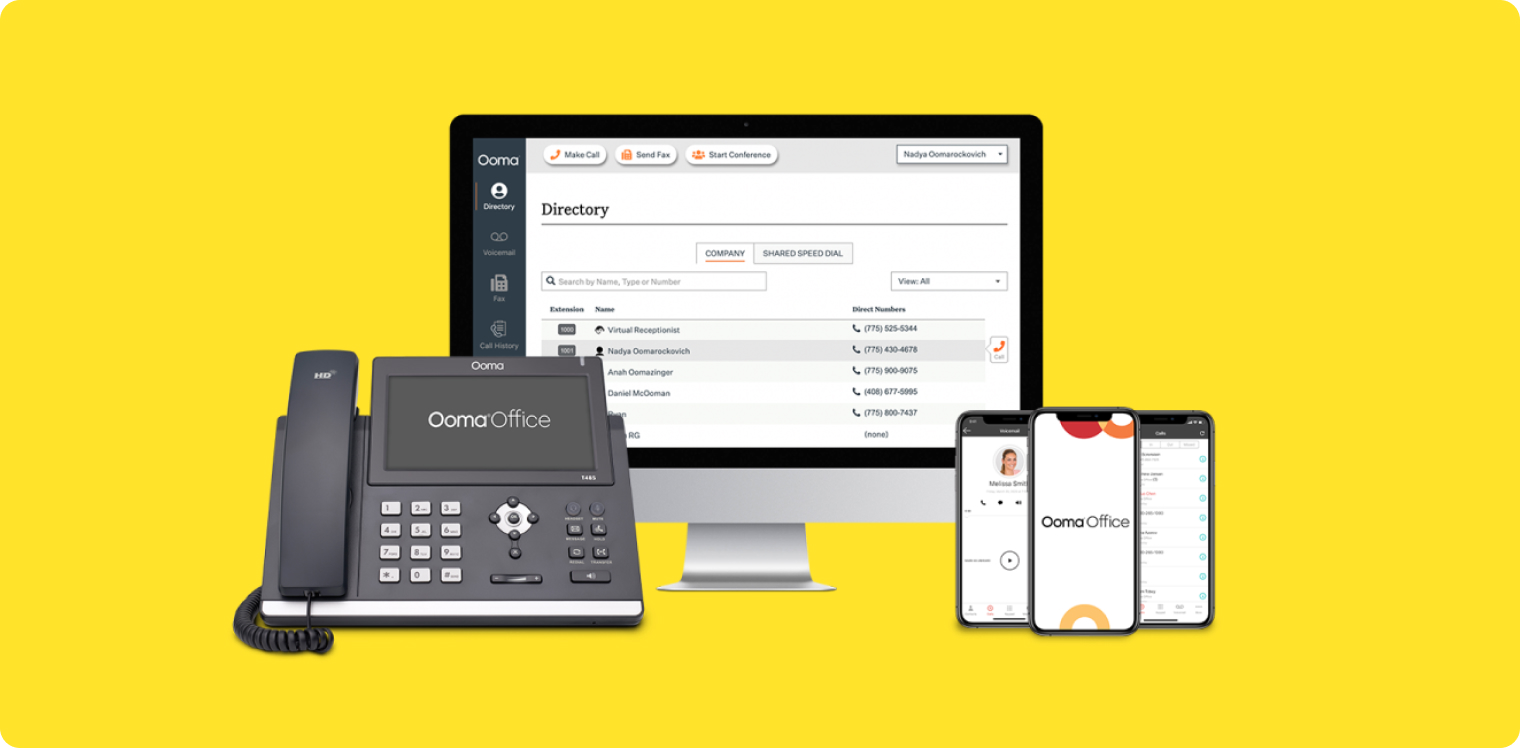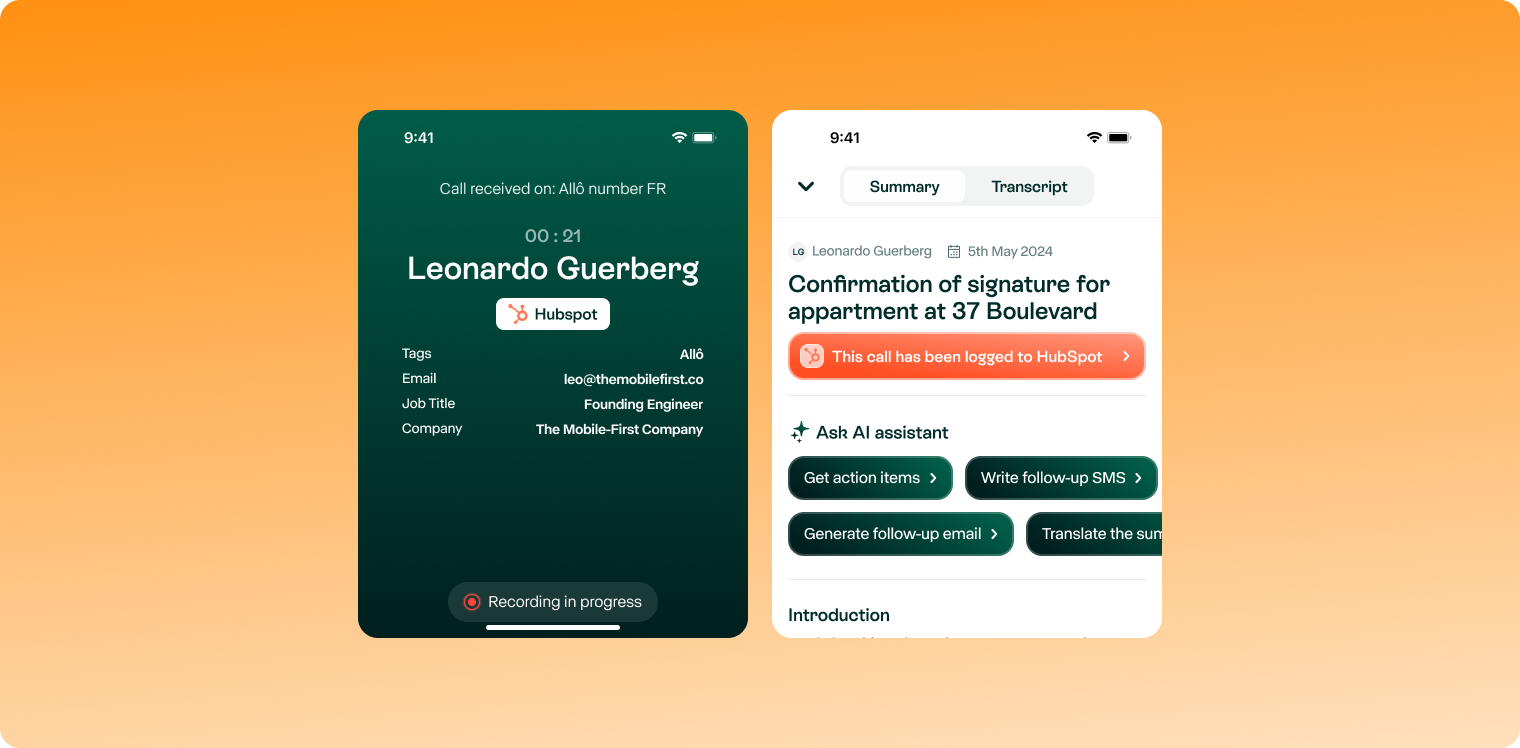When Ooma first launched in 2004, its focus was on homeowners wanting faster, more reliable phone calls. It became so successful that it branched into business communications. Today, Ooma Office is one of the best-known legacy phone systems for small businesses.
But just because Ooma is a well-known service doesn't mean it's best for your needs. Truth be told, Ooma’s not always the most reliable service. And for growing small businesses, its features are limited at best.
So we’ve gone and collected the best alternatives to Ooma’s residential and business plans so you can make an informed decision. We explore each alternative's features, pricing, and reviews. We also provide a few video demonstrations so you can see each platform in action.
What Are the Cons of Ooma?
We spent most of our time testing Ooma Office’s business phone service. But we also chatted with personal users currently using Ooma Telo (their home phone service).
Most residential customers had good things to say about Ooma. We were told it comes with all the key features you might expect for basic service, plus a solid VoIP service if you have a strong internet service provider.
But we were also warned Ooma Office for business use left a lot to be desired. And after testing it ourselves, we can confirm that’s the case.
TL;DR: Many Ooma users complain about hidden fees, limited integrations, poor call quality, a lack of AI, and few automations.
We broke down our findings into the categories below.
Hidden Fees Add Up
Since Ooma Office doesn’t offer a free trial, we had to pay for a plan up front.
We were surprised to see how high our bill was for the first month—much higher than we saw on the pricing page.
For a single business user, the base price clocked in at $19.95/user/month. We were also given a list of other fees:
- Directory assistance (411): $0.99/call
- One-time activation fee: $29.95
- Texting: $0.0095/message over the Pro plan's limit
- Toll-free calling: $15.99/month for 1,000 minutes (plus 2.9¢ per extra minute)
- Toll-free numbers: $9.95/month per additional toll-free number
- Additional local numbers: $9.95/month
- International calling: $0.02 to $0.48/minute/location
- Extended warranty: $39.99/year
Our bill came in at $49.99 if we continued with our first month, even if we tried to port an existing number.
Sidenote: Personal users have their own separate fees to consider. But you'll have to call their service call center for a more detailed breakdown of pricing.
Limited Third-Party Integrations
Ooma offered a single third-party integration on our plan (if you can call it that): a Google Chrome extension. We were told we had to upgrade to access more robust third-party integrations.
According to the pricing page, Ooma Office only offers integrations on the Pro plan and up. But the Pro plan only comes with three extra integrations — Microsoft Office 365, Google Workspace, and NexHealth for dental offices. The Pro Plus plan unlocks the rest.
Add them all up, and you’ll get a grand total of 18 integrations. But several of them won't apply to most small businesses. It's also a significantly smaller number than other cloud phone systems. Allo, for example, offers many integrations right from the base plan.
And no matter how much you pay, you’ll see it’s missing core platforms like Shopify, Zapier, and Webhooks.
Missing Automations
Workflow automations can help you put repetitive work on autopilot. But we couldn't find many when testing Ooma Office's software.
For example, you won't be able to:
- Send a missed call text back message whenever a caller reaches your voicemail
- Record phone calls automatically (unless you upgrade to the Pro plan)
- Read automatic summaries and transcripts of calls, so you'll have to re-listen to every conversation to find specific details
You can access features like the Ooma Auto Dialer, but this is only available on the Pro Plus plan ($29.95 per user per month).
Poor Call Quality
In our experience, Ooma Office's call quality left much to be desired. This was especially true when calling via WiFi instead of Ethernet.
We also had some trouble reaching customer support to resolve reliability issues. Although Ooma lists "24×7 support" on its website, we found ourselves waiting multiple days before hearing back from team members.
We're not the only ones who ran into this issue, though.
Here are a few users who reported the same issues on G2:
"The last few months have had service issue after service issue. Reaching customer support is practically impossible." — Brad
"The only real downside to Ooma is that you are dependent on a stable and reliable internet connection...which includes not just the internet provider service, but your modem hardware working properly." — Austin
"The call quality was lacking. There was a lag time between when I would speak and when the other person would hear me. This caused issues of us seeming to talk over each other. I would hear my own voice echo." — Michael
No AI-Powered Features
Most modern VoIP providers offer AI features on every plan. Not so with Ooma—we found there are no AI features on its small business plans.
Support told us the only way around this was to upgrade to the Enterprise plan, which isn't currently listed on the website. Even then, you'll only have access to AI virtual agents.
Thankfully, Ooma Office is the exception rather than the rule. The best business phone systems (including VoIP providers like Allô) bake AI voice agents into every plan.
How We Selected the Best Ooma Alternatives
We used a two-step process to whittle down the best Ooma alternatives.
First, we gathered up a list of the 20 top Ooma competitors based on user reviews, G2 ratings, and features advertised on their websites. Then, we tested each platform for ourselves to see how each platform really measured up.
We kept the top six providers meeting 50% or more of this criterion:
- Ease-of-use: It should get easier, not harder, to use your phone service over time. We specifically looked for providers offering intuitive, navigable interfaces, plus easy-to-use call management tools you can learn in a snap.
- Pricing: Dollar signs aren't everything in choosing VoIP technology, but they definitely make a difference in your monthly phone bill. We opted for virtual phone systems with easy-to-understand pricing, plus built-in "value boosts" like free calls and SMS credits.
- Integrations: Can you connect with the tools you're already using? And is there space to connect more as your business grows?
- AI features: Ooma Office may not offer many AI features, but most other providers do. The virtual phone systems on this list offer AI features so you can better automate routine business tasks.
- Security features: You shouldn't have to stress about whether your calls are secure. We selected Ooma Office alternatives with transparent security features on every plan.
- Mobile app experience: Are the provider's calling features designed for mobile-first experiences? Providers heavily focused on desk phones and legacy tech were pushed to the bottom of our list.
- Call quality: How reliable is the VoIP service? Entries on this list were ranked in quality surrounding phone calls, uptime, and fallback options in case of outages.
When it was all said and done, there were six providers left from our original 20.
We were left with the following Ooma competitors:
*Pricing and country coverage vary by plan and region. Verify during checkout.
Keep reading for an even more thorough breakdown of each Ooma alternative and how they stack up.
Allo vs. Ooma Office
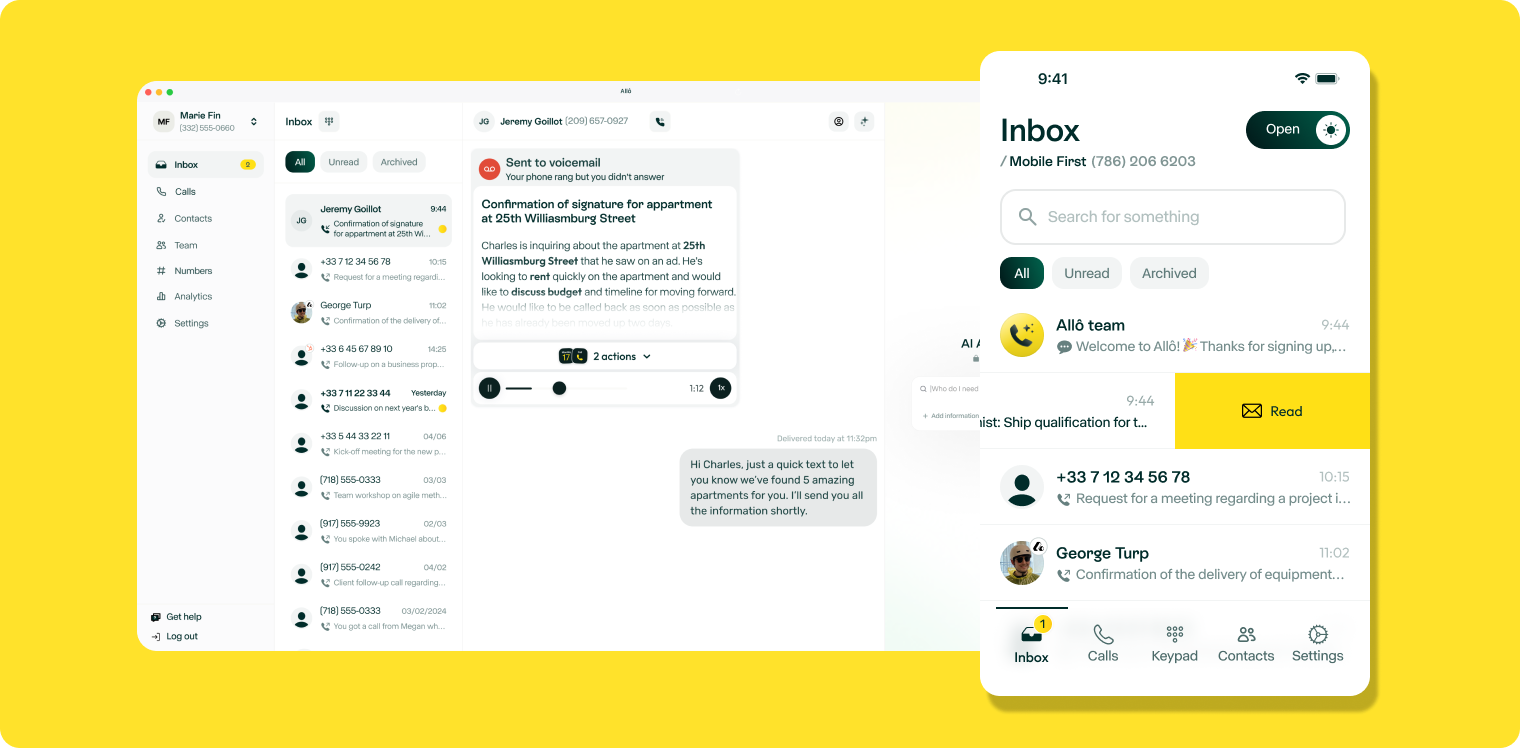
TL;DR: Allo is best for sales teams and entrepreneurs looking for a simpler way to manage business communications. It offers advanced features and AI workflows so you spend more time selling and less time troubleshooting.
Why is Allo a Good Ooma Alternative?
Ooma Office makes sense for large or well-established businesses needing communication tools for physical desks and offices. But if you're not using desk phones or making calls from a cubicle, you might wind up paying extra for tools you don't need (like overhead paging or business-wide intercom).
That's where Allo takes the cake: a robust AI phone system that helps sales teams tap into advanced VoIP features without the enterprise price tag.
We offer a mobile-first experience with all the key features you might expect from a phone system, such as texting, phone menus, and inbound and outbound calling. Then, we add the bells and whistles that growing small businesses deserve—like call summaries, smart routing, AI answering services, and much more.
Because Allo was built for modern teams, it can't match Ooma Office's features for paging, hot desking, and other legacy tools. But if you're a hybrid or remote team wanting to take work on the go, we're easily the best Ooma alternative for building relationships, increasing sales, and saving time as an entrepreneur.
Allo Reviews
Allo is one of the highest-rated VoIP phone systems on G2, with a total rating of 4.9/5.
You can see how much our customers rave about the platform being easy to use:
“What I like most about Allo is how easy it was to get started and how reliable it feels in everyday use. The call quality is consistently excellent, and the automatic call summaries save me a lot of time by eliminating manual note-taking. I also really appreciate the seamless CRM integration, which ensures all my customer interactions are logged without extra effort. The combination of call clarity, automation, and smooth integrations has significantly improved my productivity.” — Felipe I.
Plus, Allo was uniquely built for modern sales teams. See how Giacomo uses Allo to save his team hours by automating routine tasks:
“Allo combines crystal-clear call quality with a beautifully simple interface, so reps actually want to use it. The tight integrations with CRM tools - especially Attio - mean every call is automatically logged with the right context, saving hours of manual work. Setup took minutes, and the team behind Allô is incredibly responsive to feedback.” — Giacomo C.
Allo Pricing

Allo offers two plans that easily grow alongside your business:
- Starter: $18/month for a local business number, unlimited domestic calling in the US and Canada, the ability to receive SMS, call recording, AI-generated post-call summaries, business hours, smart call routing, an AI receptionist, and more advanced features
- Business: $32/user/month for a local or toll-free business number, multi-device sync, SMS and MMS support, unlimited AI receptionist calls, 1,000+ integrations, call insights, international calling to 110+ countries, and access to the web and desktop app
Demo of Allo
Google Voice vs. Ooma Office

TL;DR: Google Voice is best for personal users who need a simple phone system with essential features. It's also a phenomenal Ooma alternative for homeowners wanting a ‘landline’ number, since you won't need to purchase an Ooma Telo wireless adapter.
Why is Google Voice a Good Ooma Alternative?
There are two different types of Google Voice plans: a free version, and a paid version. The free version comes with basic calling capabilities that make sense for personal users and microbusinesses (i.e., calling features and texting). But the paid version—Google Voice for Google Workspace—best competes with Ooma's service.
With Google Voice for Google Workspace, you'll have access to call forwarding, text messaging, and unlimited calling in the US and Canada—but only if you're also located in the US. But like Ooma, there's also no free trial available, so you can't try before you buy.
Now, Google Voice’s "free" plan does require payment if you want to port in a number. They asked us to pay $20 to port in, and $3 to port out. So we simply used a second phone number in their database instead.
We subscribed to the Standard plan ($10 per user per month) and saw a few key features reserved for US-citizens only. This was unfortunate. As a fully-remote team spread between Miami, Paris, and Buenos Aires, we weren't able to make unlimited calls or tap into team messaging outside of the US.
It wasn't long before we realized that Google Voice isn't a perfect analog to Ooma Office. Its call management features, for example, are extremely limited, as you can see below:
- No support for video meetings or video conferencing like Ooma
- No 24/7 customer support
- No AI features like AI voice agents
- No unlimited users on the base plan (10 max)
So to summarize: if you're looking for an Ooma Telo wireless adapter alternative in the US, a free Google Voice plan can help you sidestep extra costs. But if you need an all-in-one platform to support small business communications, you'll likely want to explore other Ooma Office competitors.
Google Voice Reviews
Google Voice is rated a bit lower on G2 than other providers: just 4.1/5 out of 162 reviews. But to be perfectly honest, it's not hard to see why.
There are missing and limited features for anyone who's not a personal user. Even if it's "good enough" right now, you might quickly grow out of it. And once you do, you'll have to pay $3 to unlock your number and port out.
“Super simple and basic. Wasn’t able to do many “enhanced” things like, keeping a text unread, or having auto-responses setup, etc. Worked great for just a small family business, but once we stared to grow, we just needed something more robust.” — Lizzy O.
Plus, there's fairly slow customer support if you ever run into trouble. No need to take our word for it, though. See what this customer had to say:
“Customer support is not up to par, the number of features is lacking compared to modern VoIP providers.” — Verified User in Food & Beverages
Google Voice Pricing

Google Voice offers three pricing tiers:
- Starter: $10/user/month for up to 10 users, free outgoing and incoming calls, voicemail, call forwarding,
- Standard: $20/user/month for auto attendants, on-demand call recording, and ring groups
- Premier: $30/user/month for automatic call recordings
Keep in mind that every Google Voice plan requires a Google Workspace subscription, which starts at $7/user/month.
That means the lowest you can pay for Google Voice is $17/user/month.
Demo of Google Voice
Vonage vs. Ooma Office
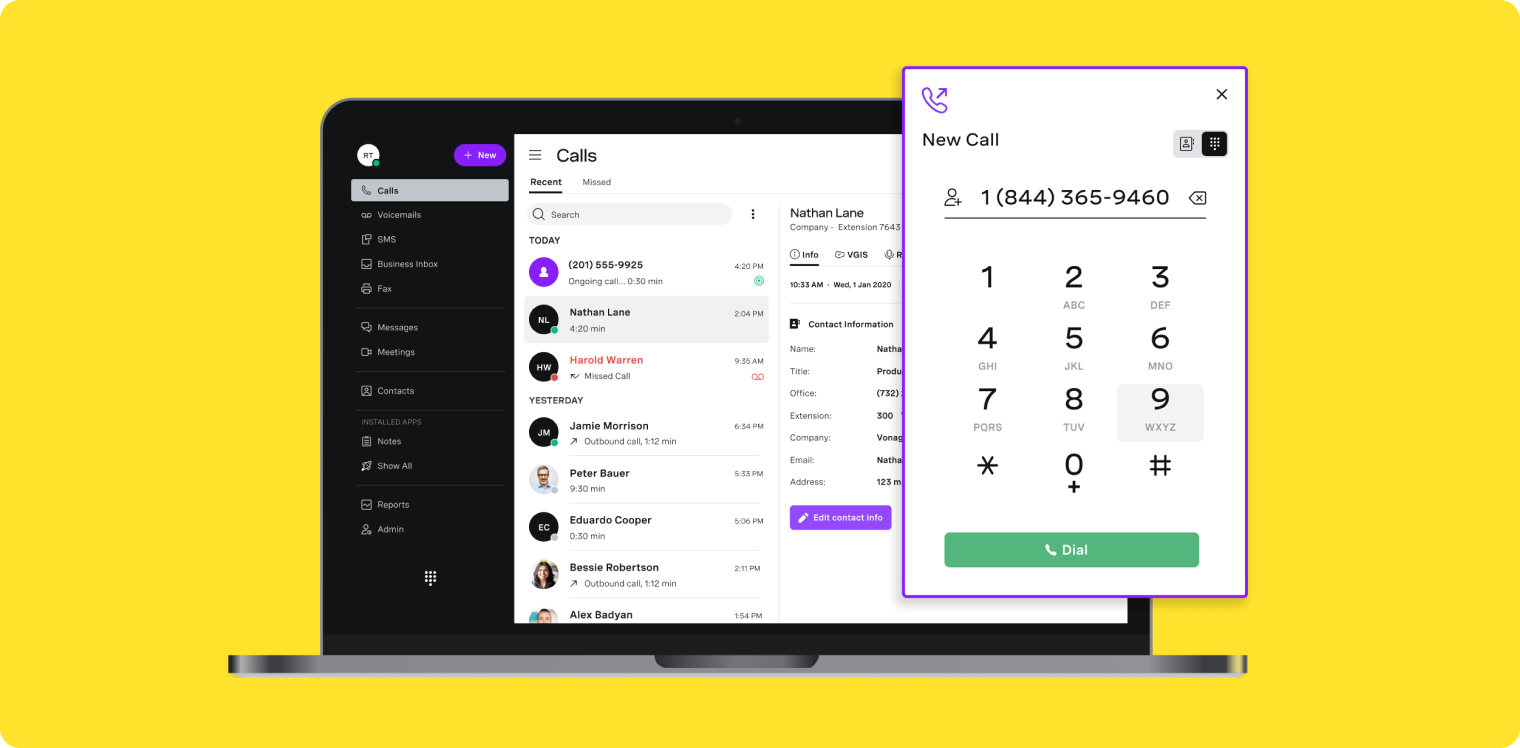
TL;DR: Vonage is one of the best Ooma competitors for residential homeowners. If you're looking to build a business, you can purchase one of its business communications plans. Otherwise, you can tap into its APIs to create a self-serve solution on your own.
Why is Vonage a Good Ooma Alternative?
Like Ooma, Vonage is a legacy VoIP provider serving both small businesses and residential homeowners. It's specifically built for unified communications: think texting, video conferencing, and SMS support.
We were happy to see a few collaboration features like team chat and basic call routing on the base tier. But certain key features—like voicemail transcriptions and on-demand call recording—were locked behind the most expensive plan. For context, this costs more than double what you'd pay for Vonage's base plan.
As an Ooma alternative for your home, sure: Vonage's home plans work just fine. But at least in a business context, the plans felt a bit restrictive, especially if you don't have any dedicated IT resources for your business.
Vonage Reviews
Vonage has a 4.3/5 rating on G2. This, as you can see, is a bit lower than other Ooma competitors.
One reason might be due to the many dropped calls—past users say they dealt with inconsistent call quality. This was something we experienced ourselves while testing the platform. But see for yourself what reviewers had to say:

If dropped calls become a recurring issue, you may need to contact support for help. Just keep in mind this may take a while. Here's what one previous user had to say:
“Some of the items on the online portal are not always intuitive in the admin area. Sometimes it takes a little while to connect to a representative when calling in with technical issues. The phones do have technical issues like dropped calls and poor connectivity often.” — Verified User in Consulting
Vonage Pricing

Vonage's plans have three different tiers:
- Vonage Mobile: $19.99/number/month for unlimited domestic calling, desktop and mobile app support, SMS and MMS options, and call transfers
- Vonage Premium: $29.99/number/month for unlimited video meetings, team chat, a virtual receptionist, analytics and reports, limited integrations, and VoIP desk phone support
- Vonage Advanced: $39.99/number/month for on-demand call recording (15 hours per month), voicemail transcriptions, single sign-on tools, and call groups
Demo of Vonage
Nextiva vs. Ooma Office

TL;DR: Nextiva is the best all-in-one platform for customer communications beyond your cellphone, like social media and chatbots. It's best suited for large or enterprise teams instead of growing small businesses or home/residential use.
Why is Nextiva a Good Ooma Alternative?
Nextiva was established just four years after Ooma, so it's no surprise the two platforms offer similar features (like video conferencing and desk phone support). But unlike Ooma, Nextiva offers omnichannel communication tools. These allow you to connect with customers anywhere, from website chatbots to messaging apps like Facebook, Instagram, and WhatsApp.
Something we liked about Nextiva was its updated user interface. Ooma Office was pretty outdated from the get-go, but Nextiva made it easier for us to navigate during our free trial.
But speaking of the free trial, this was hard to get. For one thing, there's no way to sign up on the website. We needed to call the sales team and set up a demo with them first.
Then, we immediately noticed the lack of integrations and automations. Even basic AI features like transcriptions and summaries were locked behind the Power Suite CX plan. For context, that's $75/user/month, or 5x the cost of the base plan.
Other Ooma Office alternatives offer AI features on every plan for less. Allô, for example, starts at just $18/month.
Nextiva Reviews
Nextiva was given a 4.5/5 rating on G2, which is about what we’d rate it ourselves. Customers, like us, appreciated the reliability of the platform, plus Nextiva's helpful customer support and service.
But what they don't seem to love is the complex interface, which can be difficult to navigate at times.
“I found the initial setup of Nextiva to be pretty difficult.” — Dante C.
Many also struggled with the configuration process — you have to call Nextiva directly to make certain changes in your admin account. Unless you're familiar with VoIP technology, or have plenty of time to wait on the phone, it might be difficult to get your system up and running.

Nextiva Pricing

There are three Nextiva plans for small businesses (billed annually):
- Core: $15/user/month for unlimited calling, up to 100 text messages, voicemail transcriptions, and basic IVR
- Engage: $25/user/month for virtual fax, unlimited call recording, toll-free numbers and minutes, unlimited video meetings, advanced call reports, and an integration with Microsoft Teams
- Power Suite CX: $75/user/month for access to Nextiva's supervisor dashboard, inbound sales and service call center, skills-based routing, and automatic call distribution callback (ACD) system
Demo of Nextiva
Quo vs. Ooma Office
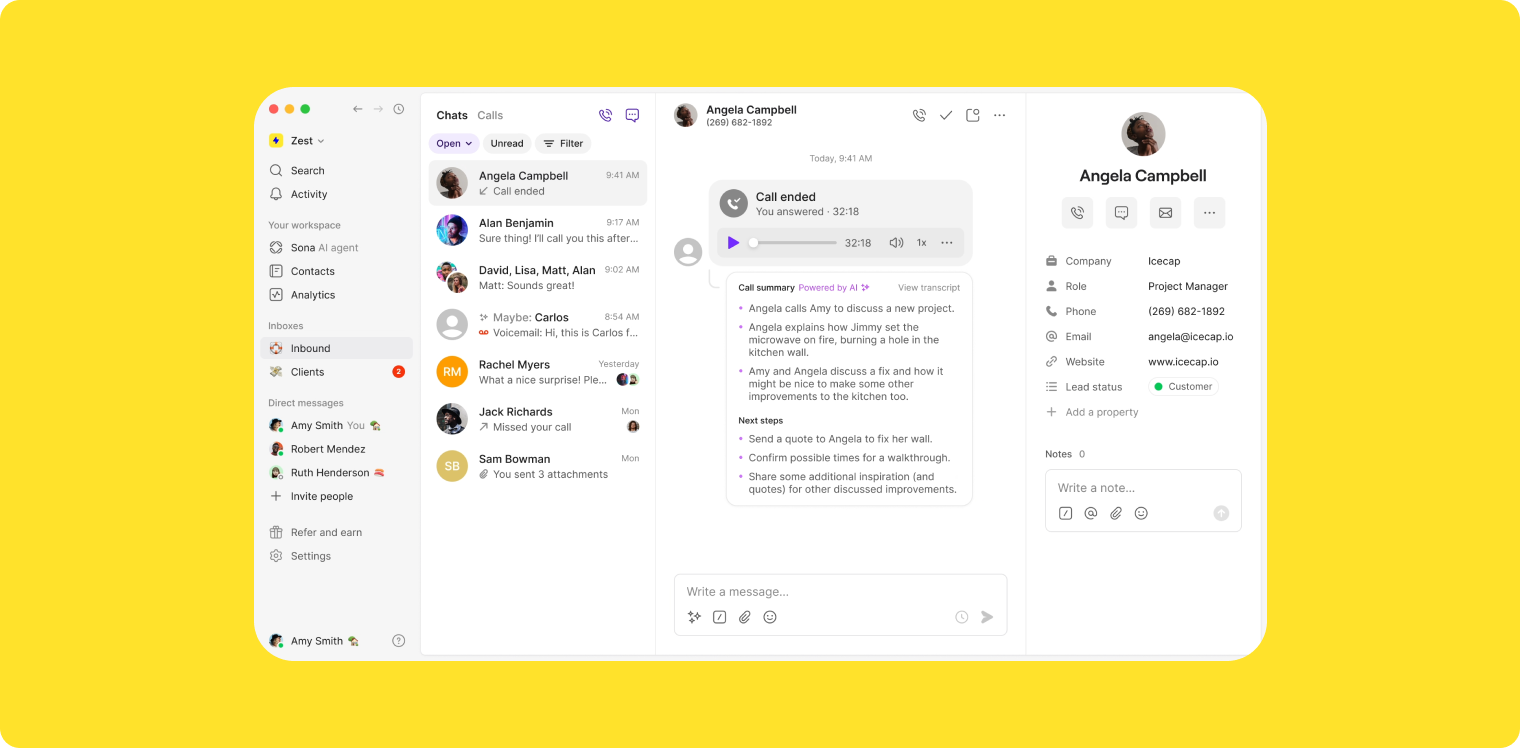
Quo (formerly OpenPhone) is the best Ooma alternative in Canada. It's a solid choice for remote or hybrid teams who want to make and receive calls on a single phone number.
Why is Quo a Good Ooma Alternative?
Quo is the rebranded name of OpenPhone, the Canadian Ooma alternative. It offers the same key features as Ooma Office, plus a few bells and whistles like shared phone numbers. No, you won't have desk phone support like with Ooma, but Quo’s mobile interface works well with personal devices.
There's a lot to love about Quo's free trial, too. Probably because Ooma doesn't offer a free trial at all. With Quo, you get seven days to test its basic calling features, visual call queue builder, and additional features like auto-replies and AI-suggested message responses.
But speaking of AI, something we didn't love about Quo was that its fully-featured AI receptionist is an add-on only. You get a few free minutes per month on the base plan, and if you want to unlock the unlimited AI voice agent, it'll be $49 on top of your plan. That's a minimum of ~$64 per month for just one user.
But with Quo alternatives like Allo, you can unlock unlimited minutes for your AI voice agent plus a single user for just $32. That's 50% less you can spend on other tasks.
Quo Reviews
Quo has a 4.7/5 rating on G2—which, in our opinion, is very well deserved.
But call quality and reliability were major sticking points for users. Just see what they had to say themselves:
“While OpenPhone is feature-rich, one downside is that call quality can sometimes vary depending on your internet connection. I also noticed that the desktop app can be a little buggy during updates. Additionally, it would be helpful if the platform offered more advanced analytics or reporting tools for tracking call performance over time. The international calling support could also be more transparent in terms of pricing and availability.” — Medical Practice User
Plus, Quo offers many features that aren't fully fleshed out. Many users say they're waiting for improvements, or at least additional support to help them work more efficiently.
“The biggest limitation I have so far is with the activity feed and organization of @mentions - there is no way to create a to-do list with your @mentions and there is no way to mark them unread - so once you click on a notification in the activity feed - you have to “resolve” it right away or you lose that “notification” and a lot of times we will triage issues and come back to things so this is really a bummer.” — Jonalynn M.
Quo Pricing

There are three plans to choose from:
- Starter: $15/user/month for the ability to share numbers with multiple team members
- Business: $23/user/month for call analytics, automatic call recording, CRM integrations, and more
- Scale: $35/user/month for AI call tags, onboarding support, and priority live chat and email ticket support
Demo of Quo
RingCentral vs. Ooma Office
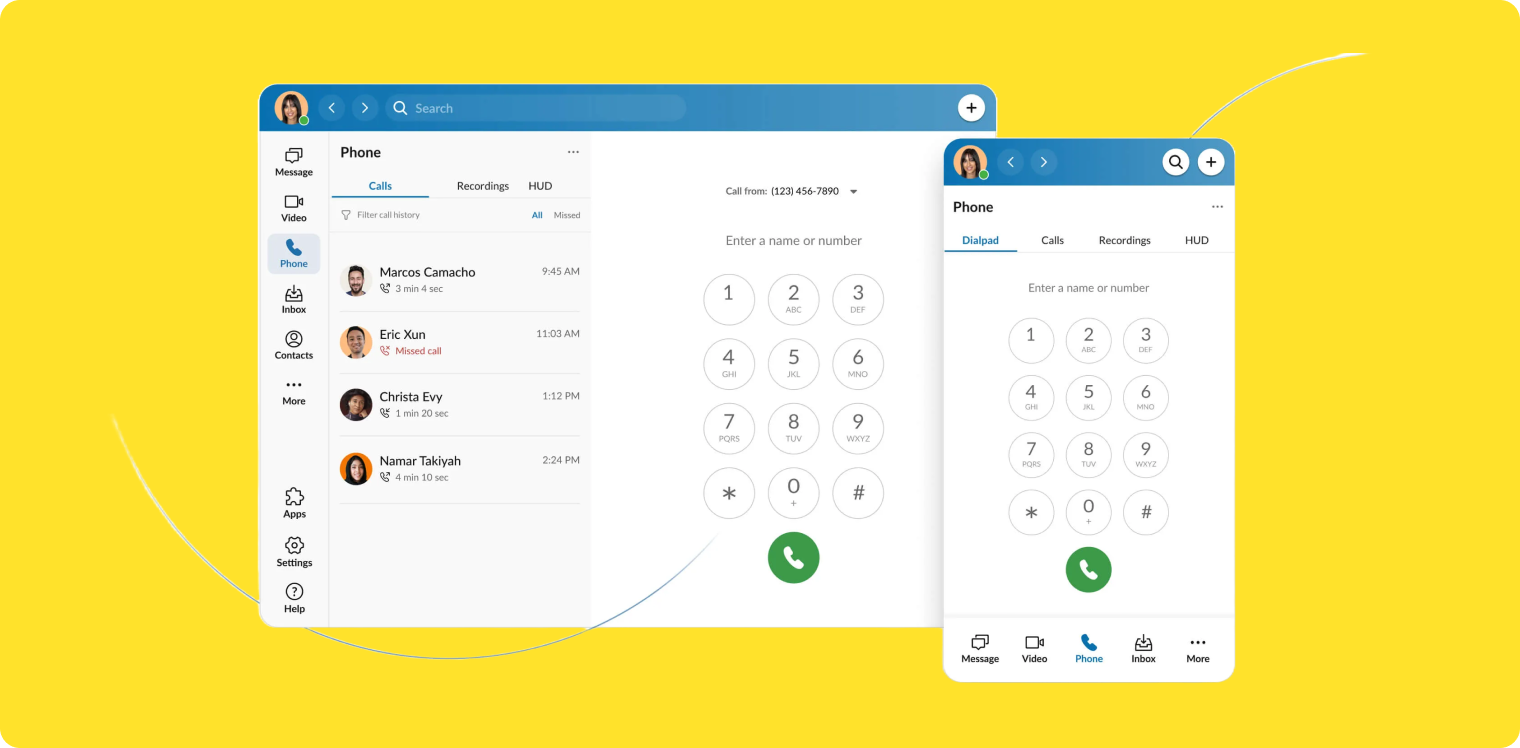
RingCentral is best for businesses wanting video conferencing, since it’s available right from the base plan. Compared to Ooma Office, which makes you upgrade for video calling, you can tap into unified communication tools right from the get-go.
Why is RingCentral a Good Ooma Alternative?
RingCentral is a legacy phone system that acts as an all-in-one platform for phone calls, text messaging, and video meetings. It's a very old system (read: 1999), but it’s gone through a few upgrades to keep the interface fresh over the years (unlike Ooma).
We loved that RingCentral offered a more straightforward free trial than Ooma. But we didn't love it was limited to a max of five users—something particularly frustrating for fast-growing businesses.
We also weren't huge fans of RingCentral's built-in restrictions. There are no unlimited toll-free minutes on any plan, or unlimited storage for that matter. Even team chat history gets deleted over time unless you keep upgrading your plan (not ideal for small businesses on a budget).
In terms of call management features, RingCentral blows Ooma out of the water. It even supports desk phones if you can't quite give them up yet.
But Ooma doesn't make you feel as forced to upgrade as RingCentral. Or needlessly restrict features to make you pay more.
This might not be a problem for small businesses just starting out, but could become an issue if you're looking to scale and need to switch platforms.
RingCentral Reviews
RingCentral has a 4/5 rating on G2.
Many users felt their call quality was inconsistent. We didn't personally experience this, but there were plenty of users who left a review like this:
“I find the quality of the calls to be inconsistent. Sometimes the call quality is low or medium, which seems to depend on the internet connection and service provider.” — Luis Enrique C.
If you wind up needing help, it could be tough to contact customer support. One user said they were waiting for nearly two business weeks to get an issue resolved for their team. See for yourself:

RingCentral Pricing

There are three RingCentral plans to choose from:
- Core: $20/user/month for unlimited calling, 25 texts, 100 toll-free minutes, interactive voice response (IVR), basic call queues, basic video conferencing with 100 participants, and limited storage for team messaging
- Advanced: $25/user/month for 100 texts, 1,000 toll-free minutes, advanced call routing, automatic call recording, multi-site management, and CRM integrations
- Ultra: $35/user/month for video conferencing with 200 participants, whiteboards, 200 texts, 10,000 toll-free minutes, unlimited storage for files and team messaging, and access to a personal AI assistant for SMS
Keep in mind RingCentral's best AI features sit behind costly add-ons. For example, we found you'll have to pay extra for:
- RingSense for AI-powered conversation intelligence
- Push-to-talk
- RingCentral Rooms connectors
- RingSense for Sales
- Live reports
- Business analytics Pro
- AI receptionists
Considering platforms like Allo give you an AI receptionist on every plan, RingCentral may not be as cost-effective as other Ooma alternatives.
Demo of RingCentral
Zoom Phone vs. Ooma Office
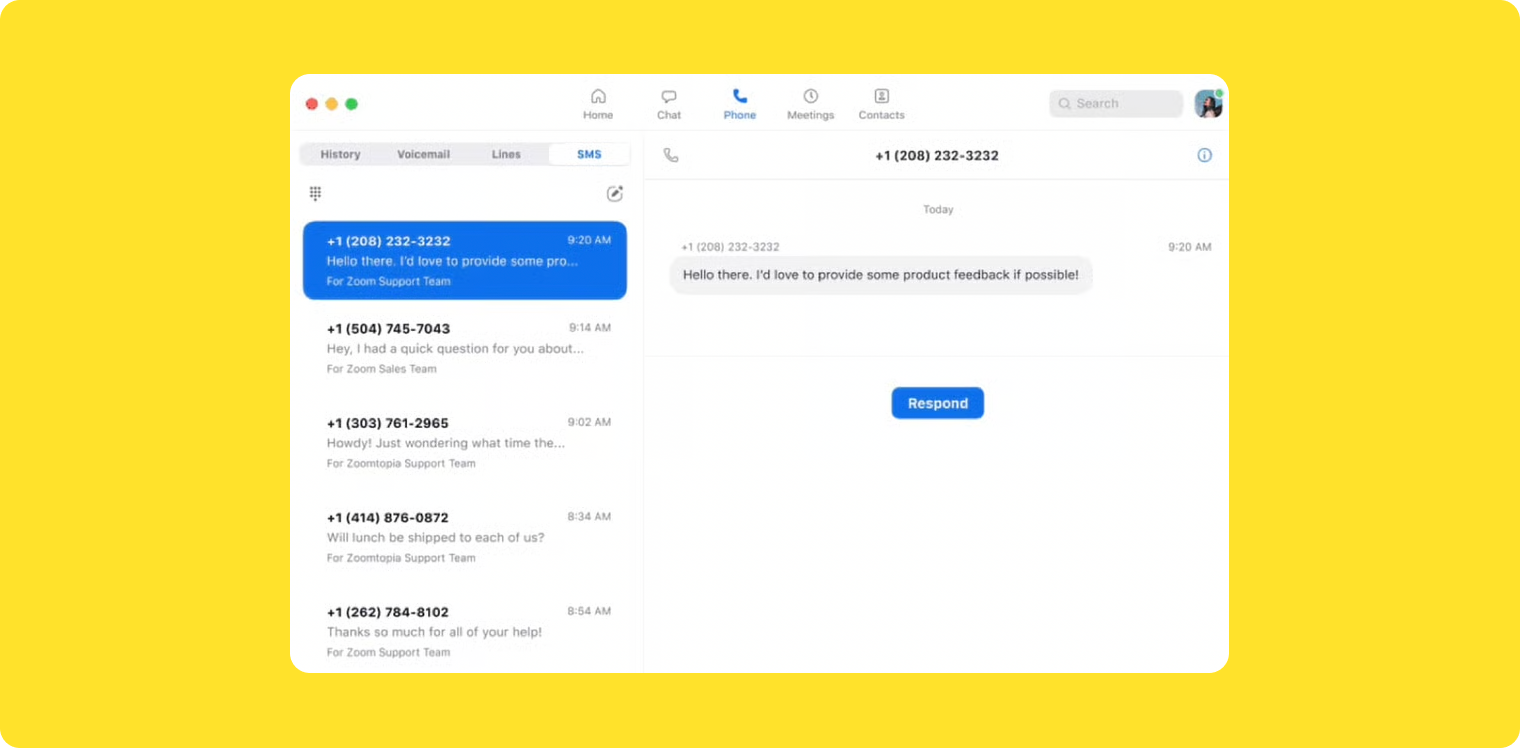
Zoom Phone is the best Ooma office alternative for people already using Zoom Meetings to connect with friends, family, and customers. It could be used for residential homeowners, or as a light business phone system. Just don’t expect too much.
Why is Zoom Phone a Good Ooma Alternative?
You're probably familiar with Zoom’s video conferencing platform if you’ve ever had to jump on a virtual meeting before. So you can think of Zoom Phone as its younger cousin. It's the same company, just with a VoIP offering built directly on its Meetings platform. This lets you call and video call your customers, friends, and team members.
We really appreciated how many management features Zoom Phone offered. It also provides metered and unmetered plans, which means you can pay as you go if you want to stretch out a shoestring budget.
But apart from a basic virtual receptionist, it didn't offer much AI. It also doesn't offer call analytics on any plan.
These might lead to issues if you want to keep a close eye on your team, track sales calls, automate tasks, or improve workflows for your team.
Zoom Phone Reviews
Zoom Phone has a 4.6/5 rating on G2.
Most users appreciate how easy Zoom Phone is to use, plus how it natively connects with Zoom's video meeting software. But between bugs, glitches, and low-quality audio/video, getting the system to work might be a little tricky. See for yourself:
“I haven't had great success with using the mobile version of Zoom. User's have issues hearing me when using the mobile features.” — Robert S.
The missing and unlimited features are also frustrating for many users. It may not offer as much value for growing small businesses.
“The Pro subscription, which is the lowest, is priced too close to the Metered subscription while lacking features like international calling, personalized mobile number, etc. This might make it a little difficult for smaller businesses to use Zoom Phone.” — Sindhu K.
Zoom Phone Pricing

Unlike Ooma, Zoom Phone offers a whopping five plans to choose from (although they're not easy to find on the pricing page).
The include:
- US & Canada Metered Plan: $10/user/month for metered domestic calling, texting in the US and Canada, Zoom meetings, and a basic auto-attendant
- US & Canada Regional Unlimited Plan: $15/user/month for unlimited outbound calls in the US and Canada, AI call summaries, and metered international calling
- Pro Plus Plan: $18.32/user/month for everything in Unlimited plus Zoom Workplace Pro
- Global Select Plan: $20/user/month for everything in US & Canada Unlimited, unlimited calls in 40+ countries, and a direct dial number
- Business Plus Plan: $22.49/user/month to access Zoom Workspace, visitor management, real-time reports, and international calling add-ons
Demo of Zoom Phone
Allo: The Best Ooma Office Alternative for Entrepreneurs
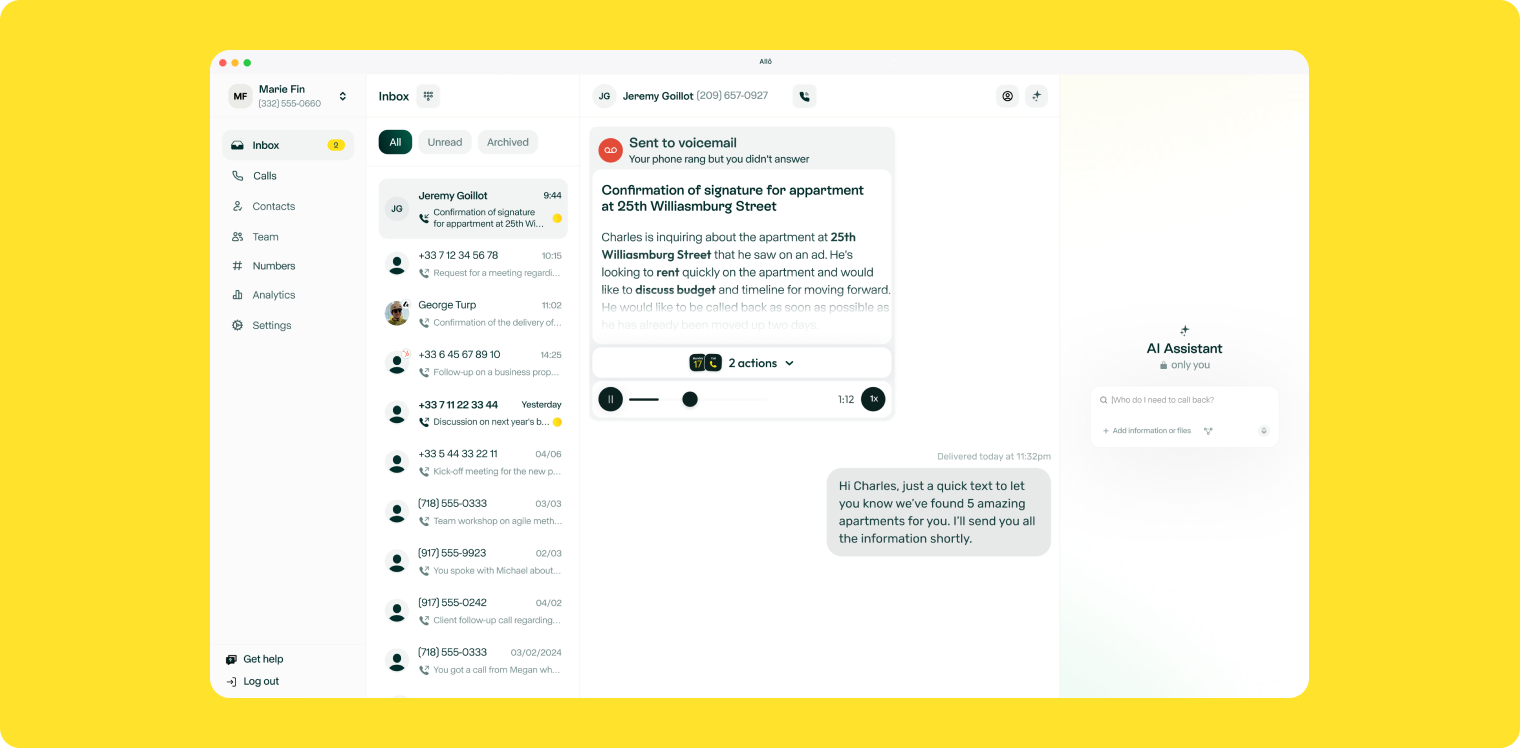
There are many different alternatives to Ooma on the market — but only one phone system truly built for entrepreneurs. Allo was designed to get you "unstuck" from legacy VoIP with modern infrastructure, clear pricing, and AI-rich tools.
No more retrofitting enterprise brands to meet your needs, or feeling trapped with personal phone providers that don't quite serve small businesses. Allô was built by and for small teams looking to uplevel their service without spending thousands on upkeep.
Frequently Asked Questions About Ooma Alternatives
[[faq-blog]]
How do I cancel Ooma?
You can't cancel Ooma Office online or from your admin portal. Instead, you'll need to contact customer support and request to terminate your account over the phone.
Past users say you'll be incentivized to stay with discounted months or the ability to pause your plan for a short while. But if you keep repeating, "no thank you, I'd just like to cancel," you'll eventually be issued a cancellation email.
What is the best Ooma alternative?
We might be biased, but we genuinely believe that Allo is the best Ooma Office alternative. You'll get unlimited calling in the US and Canada, plus SMS features and a robust 24/7 receptionist. You can also tap into automations, integrations, and AI-powered transcription features on any plan.
What’s the most affordable Ooma alternative?
Allo is the most affordable Ooma alternative when you compare the hidden fees. Including activation fees, overage costs, and other hidden costs, the true cost of Ooma can climb up to $50+ per month.
With Allo, you don't have to worry about hidden fees or add-on costs. Everything you need is listed on Allo's transparent pricing page. Prices start at $18/month, which may be less than half what you pay to get started with Ooma.
What are the best residential alternatives to Ooma?
Most homeowners wanting an Ooma Telo alternative settle on:
- Google Voice for mobile service
- Vonage for home phone and landline service
- CallCentric for cheap, tech-y setups
- magicJack for hardware and adapters
- Ringblaze for calling and texting support






.svg)

























